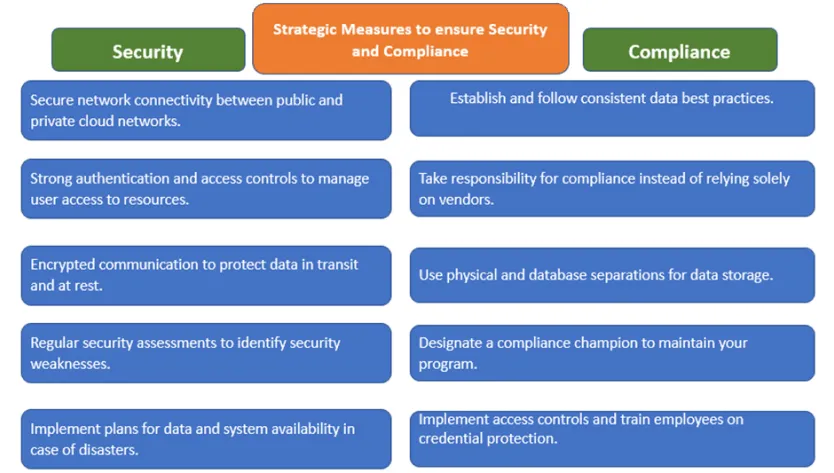Blogs / Hybrid and Multi-cloud
Best Practices To Structure An Enterprise Hybrid Cloud Strategy
By
Sibin Vincent
Posted: October 24, 2022
• 4 Min Read
Hybrid cloud is gaining traction among enterprises looking for efficient and cost-effective technology solutions due to its ability to combine the benefits of both public and private clouds. With the flexibility and scalability of public clouds and the security and control of private clouds, hybrid clouds can provide organizations with a customized and optimized cloud environment.
However, for IT teams, the complexity of installing and maintaining cloud environments has grown significantly due to the array of connections, integrations, portability issues, resource options, orchestration, and storage choices available. Hence, it is important to build an efficient strategy before you go ahead with hybrid development. Find out some of the best practices you should include while creating a hybrid cloud strategy for your business.

Best Practices To Structure An Enterprise Hybrid Cloud Strategy
-
Identify your Business Objectives and Cloud Requirements
-
Collaborate with Stakeholders
-
Assess Current Infrastructure
-
Plan Workloads
-
Think About the Budget
-
Choose Cloud Providers
-
Determine your Workload Distribution Strategy
-
Define Security and Compliance Policies
-
Get Visibility in Cloud Operations
-
Establish Governance and Management Practices
- Identify your Business Objectives and Cloud Requirements
- Collaborate with Stakeholders
-
CIO and CTO - To provide guidance on the organization's overall IT strategy and goals.
-
Cloud architects - To help evaluating cloud providers and design your hybrid cloud architecture.
-
Database administrators - To assist in data migration, data security, and performance tuning.
-
DevOps team – To help with application migration, integration, and automation.
-
Security team - To help in ensuring your cloud environment is secure and compliant with industry regulations.
-
Project Managers – To help in planning and managing the migration process.
-
End-users – To provide input on the functionality and user experience of the cloud applications.
- Assess Current Infrastructure
- Plan Workloads
- Think About the Budget
- Cost structure: Understand how your cloud vendor calculates costs so you can accurately budget and forecast expenses.
- Financial benefits: Factor in these benefits that the cloud offers when determining your budget.
- Visualize current and future use: Plan how your cloud service can scale alongside your applications to achieve greater flexibility and cost savings in the long run.
- Service Usage: Strategically manage resource usage to control your cloud budget.
- Choose Cloud Providers
- Amazon Web Services (AWS): With its vast range of services and largest cloud infrastructure, AWS is a leading cloud provider for businesses of all sizes.
- Microsoft Azure: Known for its security, scalability, and emphasis on enterprise needs, Azure is a popular choice for larger organizations that require strong interoperability.
- Google Cloud Platform (GCP): Offering a robust suite of services and flexible pricing models, GCP is an attractive option for businesses seeking a scalable, customizable, and cost-effective cloud solution. Startups may find GCP's service flexibility to be advantageous.
- Determine your Workload Distribution Strategy
- Define Security and Compliance Policies
- Get Visibility in Cloud Operations
- Establish Governance and Management Practices
Let's discuss the above points in detail:
The first step in creating a hybrid cloud strategy is to identify your business objectives and cloud requirements. You need to understand what your organization is trying to achieve and how the hybrid cloud can help. You should also consider the workload requirements and the level of security and compliance needed.
To ensure a successful strategy planning, it's important to involve the right people with the necessary skills and knowledge. Some of the team members you can include in the decision-making process are:
Assessing the current infrastructure involves evaluating your existing applications, data, and IT systems. This will help you identify which workloads can be moved to the cloud and which ones should remain on-premises. Also, consider the compatibility of your existing systems with the hybrid cloud.
You can refine the cloud strategy by balancing workloads between Public and Private Clouds for optimal performance and control. Carefully consider which applications to host on your private cloud versus the public cloud. Utilize specialized tools available in your private cloud to adjust your infrastructure and manage workloads more effectively. Leveraging automation and workload management tools like Kubernetes can further enhance efficiency and orchestrate containerized workloads.
Investing in hybrid cloud platform requires careful planning and consideration. By strategically budgeting for a hybrid cloud architecture, your organization can save money in the long term. Check out some tips to keep in your mind:
Select the right public cloud provider who can meet your business requirements and integrate well with your existing infrastructure. Factors such as cost, storage options, reliability, security, and compliance strategies provided offered by the cloud providers must be considered. You can choose from the cloud service providers that dominate the worldwide cloud market namely AWS, Microsoft Azure, and Google Platform.
Decide which workloads should be moved to the public cloud and which ones should remain on-premises. Consider factors such as workload requirements, data sensitivity, and compliance requirements while distributing workloads. To implement a hybrid cloud strategy, it is possible to integrate a private cloud platform with an existing public cloud provider such as AWS, GCP, or Azure. Similarly, if you have a privately owned and managed cloud, you can choose a public cloud to gain added flexibility and reduce your costs.
Do you adhere to any industry-specific compliance standards for cloud services, such as GDPR, SOC II, PCI, or HIPAA? Take this as a crucial part of your hybrid cloud strategy as this decision will have an immediate impact on how your data is managed and protected. Consider the security and compliance requirements for both public and private clouds. In addition to this, the roles and responsibilities of your cloud providers, IT staff, and end-users to ensure this must be outlined.

To ensure alignment and clarity in hybrid cloud architecture setup and management, it's crucial to have greater visibility. This can be achieved by accessing real-time data from your cloud for an accurate overview and filtering to focus on the most relevant one. By doing so, your team can stay informed and up to date on what's happening in your cloud environment.
In order to ensure the success of your hybrid cloud strategy, you need to establish governance policies and procedures to ensure that the complex and dynamic cloud environment of an organization is aligned with its policies, security best practices, and compliance obligations. This helps you to establish a framework of policies, procedures, and controls that govern the use of cloud resources and ensure that they are deployed, managed, and used in a secure and compliant manner.
Conclusion
By following these steps, you can structure an enterprise hybrid cloud strategy that meets your business requirements and ensures the success of your hybrid and multi-cloud implementation. Don't wait any longer if you aim to expand your business with a carefully planned approach. Get in touch with our cloud consulting experts today to discover how we can provide you with comprehensive hybrid and multi-cloud development services, tailoring a customized strategy that aligns with the specific needs of your enterprise.


Get Know More About Our Services and Products
Reach to us if you have any queries on any of our products or Services.











